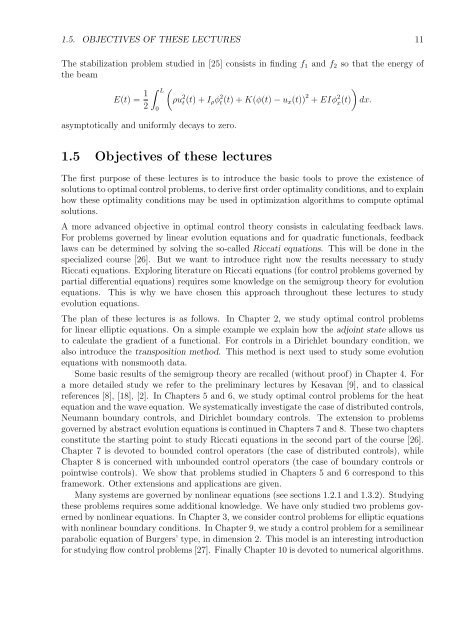Optimal Control of Partial Differential Equations
Optimal Control of Partial Differential Equations
Optimal Control of Partial Differential Equations
You also want an ePaper? Increase the reach of your titles
YUMPU automatically turns print PDFs into web optimized ePapers that Google loves.
1.5. OBJECTIVES OF THESE LECTURES 11<br />
The stabilization problem studied in [25] consists in finding f1 and f2 so that the energy <strong>of</strong><br />
the beam<br />
E(t) = 1<br />
2<br />
L<br />
asymptotically and uniformly decays to zero.<br />
0<br />
<br />
ρu 2 t (t) + Iρφ 2 t (t) + K(φ(t) − ux(t)) 2 + EIφ 2 <br />
x(t) dx.<br />
1.5 Objectives <strong>of</strong> these lectures<br />
The first purpose <strong>of</strong> these lectures is to introduce the basic tools to prove the existence <strong>of</strong><br />
solutions to optimal control problems, to derive first order optimality conditions, and to explain<br />
how these optimality conditions may be used in optimization algorithms to compute optimal<br />
solutions.<br />
A more advanced objective in optimal control theory consists in calculating feedback laws.<br />
For problems governed by linear evolution equations and for quadratic functionals, feedback<br />
laws can be determined by solving the so-called Riccati equations. This will be done in the<br />
specialized course [26]. But we want to introduce right now the results necessary to study<br />
Riccati equations. Exploring literature on Riccati equations (for control problems governed by<br />
partial differential equations) requires some knowledge on the semigroup theory for evolution<br />
equations. This is why we have chosen this approach throughout these lectures to study<br />
evolution equations.<br />
The plan <strong>of</strong> these lectures is as follows. In Chapter 2, we study optimal control problems<br />
for linear elliptic equations. On a simple example we explain how the adjoint state allows us<br />
to calculate the gradient <strong>of</strong> a functional. For controls in a Dirichlet boundary condition, we<br />
also introduce the transposition method. This method is next used to study some evolution<br />
equations with nonsmooth data.<br />
Some basic results <strong>of</strong> the semigroup theory are recalled (without pro<strong>of</strong>) in Chapter 4. For<br />
a more detailed study we refer to the preliminary lectures by Kesavan [9], and to classical<br />
references [8], [18], [2]. In Chapters 5 and 6, we study optimal control problems for the heat<br />
equation and the wave equation. We systematically investigate the case <strong>of</strong> distributed controls,<br />
Neumann boundary controls, and Dirichlet boundary controls. The extension to problems<br />
governed by abstract evolution equations is continued in Chapters 7 and 8. These two chapters<br />
constitute the starting point to study Riccati equations in the second part <strong>of</strong> the course [26].<br />
Chapter 7 is devoted to bounded control operators (the case <strong>of</strong> distributed controls), while<br />
Chapter 8 is concerned with unbounded control operators (the case <strong>of</strong> boundary controls or<br />
pointwise controls). We show that problems studied in Chapters 5 and 6 correspond to this<br />
framework. Other extensions and applications are given.<br />
Many systems are governed by nonlinear equations (see sections 1.2.1 and 1.3.2). Studying<br />
these problems requires some additional knowledge. We have only studied two problems governed<br />
by nonlinear equations. In Chapter 3, we consider control problems for elliptic equations<br />
with nonlinear boundary conditions. In Chapter 9, we study a control problem for a semilinear<br />
parabolic equation <strong>of</strong> Burgers’ type, in dimension 2. This model is an interesting introduction<br />
for studying flow control problems [27]. Finally Chapter 10 is devoted to numerical algorithms.

















